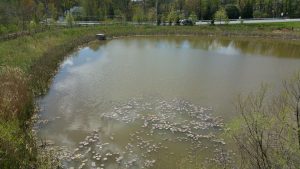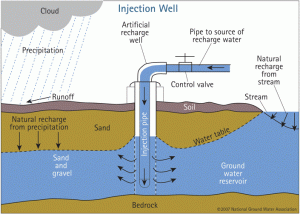Why Recharge?
With an ever increasing demand for water, it’s only natural that water conservation measures would grow in importance. One such measure is ground water recharge, which replenishes aquifers. But instead of waiting for time and Mother Nature to absorb and filter surface water, artificial ground water recharge can be performed. This is done by channeling surplus surface water deeper into the ground.
Artificial recharge serves a combination of benefits, such as:
- replenishing the underground aquifer
- acting as storage for surplus rainwater, which can then be recovered during times of water scarcity
- preventing intrusion of sea water into the aquifer in coastal areas
- maintaining base flows in streams
- raising the ground water level, which reduces the costs of pumping
Artificial recharge is common in areas with limited surface water availability, since there is a strong need for ground water for drinking and agriculture.
Recharge Processes
Surface Infiltration
Artificial recharge can be accomplished through surface infiltration or a deep injection well. Surface infiltration systems begin by creating shallow basins on the land’s surface. Water is dumped into these basins for infiltration. These systems depend on the availability of permeable soils capable of high infiltration rates (around 10 feet per day). This is because when water passes through soil layers, many physical, chemical and biological pollutants are filtered out.
One downside to surface infiltration systems is water loss from evaporation (from the wet top soil). But this loss is still considerably less than the amount of water that can potentially infiltrate into the ground.
In a surface infiltration basin, some of the factors that influence infiltration rates are:
- the depth of the infiltration basin
- the number of suspended particles in the water used for infiltration
- the ground water level
Shallow infiltration basins tend to result in better infiltration rates compared to deeper basins. Also, higher ground water levels in the area where infiltration is performed will hamper infiltration rates.
In general, the vertical distance between the infiltration basin’s water surface and the ground water level should be at least twice the infiltration basin’s width. Another design consideration pertains to water quality. High ground water levels mean fewer soil layers are available for filtration. When the quality of the water entering the ground is questionable, it’s safer not to have the infiltration system where ground water levels are high.

Deep Injection Well
The other mode of infiltration is through injection wells. These are appropriate when the soil surface is not permeable, or if large tracts of land aren’t available for setting up a surface infiltration system.
An injection well system consists of a:
- casing
- pipe inside the casing to inject the water into the aquifer
- gravel pack
- well screen where the pipe merges with the aquifer
The injection well system is prone to clogging at the interface between the gravel pack and the aquifer. This can adversely impact infiltration rates. This can be resolved by pumping the water out periodically (this can range from 20 minutes every day to a few times a year). How often pumping is necessary depends on the reduction in infiltration rates – higher reduction rates necessitate frequent pumping. A prerequisite to prevent clogging is by pretreating the water to remove suspended solids and other nutrients such as phosphorous and nitrogen.

Artificial Recharge Through Wells in India:
In India, artificial recharge is accomplished through recharge wells. In comparison to an injection well, recharge wells are much wider in diameter (they range from 3 feet to 10 feet) and are more shallow in depth (20 feet to 40 feet). Recharge wells are in the storm water drains, since these drains receive the maximum flow volume of surface rain water runoff.
Recharge wells are made by digging a pit in the designated location and then lowering pre-cast concrete rings into the pit. The rings are stacked one on top of the other. The top is covered with a reinforced cement concrete slab with an access cover. A very simple drain filter and silt trap is incorporated into the drain just before the recharge well. They serve to block floating debris and trap heavy soil. Beyond this, no additional filtration is required since the water will pass through layers of soil from the bottom of the well, and soil is the best natural filtration agent.
Recharge wells are generally seen as a mechanism to replenish the shallow aquifers, and over time, the deeper hard rock aquifer as well. In some cases, over a period of sustained recharge, the recharge wells can become discharge wells due to the increase in the ground water table.
Case Study: The Benefit of Recharge
A gated community in Bangalore (spread over 36 acres) started doing recharge wells as a flood control measure back in 2007. This community was off the city water supply grid and relied on ground water and water supplied from private tankers (which was also ground water albeit extracted from a different location/ borewell).
As the community’s population started increasing, more houses were constructed, and the stress on the water supply increased proportionally. In a few years, this snowballed into a severe crisis. They reached a point where none of their borewells (of various depths) were yielding water. They were completely dependent on private tankers. The paradox was that on the one hand, they had so much rain water running off that it resulted in flooding. On the other hand, they were facing a water shortage. This catalyzed them to take another look at the wells from a recharge perspective rather than just as a flood control measure.
A video illustrating the making of a recharge well (Source – Indiawaterportal)
A slew of measures was taken – increasing awareness among residents, having dedicated personnel for monitoring water related metrics, incentivizing for investing in recharge wells, etc. This resulted in the number of recharge wells increasing exponentially. In 2007, there were around eight. In 2016, there are around 330 with a combined annual recharge potential of 99 million liters. The icing on the cake was that two of their shallow borewells started yielding water due to the amount of recharge.
They are now completely water self-sufficient except for a couple of months in summer when they depend on private tankers. This is an enviable situation compared to the neighboring communities who are at the mercy of private tankers all year long. If this can be replicated across communities, cities, and countries, it will result in significant mitigation of water supply related crises.
References:
- https://www.nap.edu/read/4780/chapter/3